Text

Grand Duchess Tatiana Nikolaevna of Russia (1897-1918) - 'Tatiana Nikolaevna Romanova'
0 notes
Text
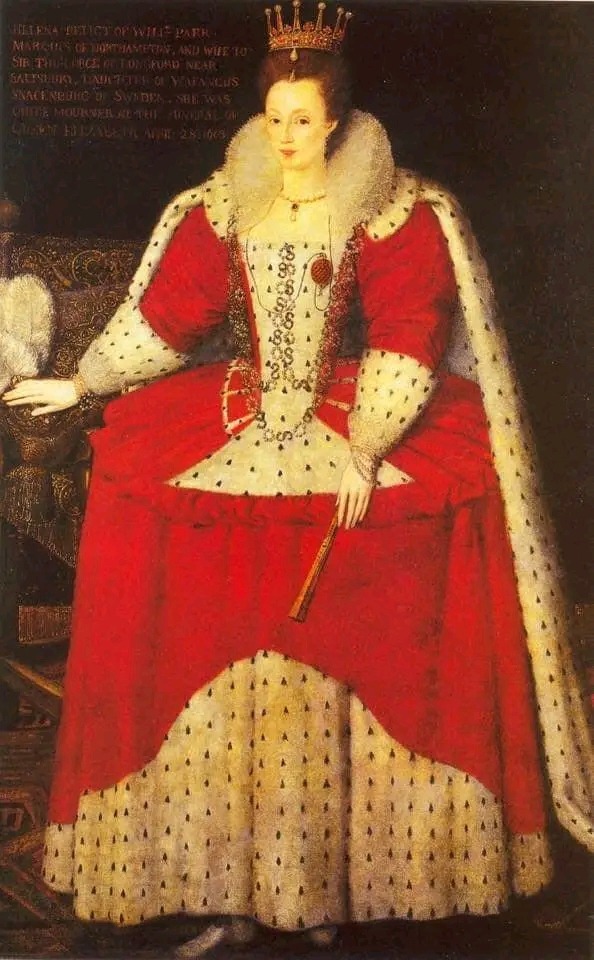
Portrait of Helena Snakenborg, Marchioness of Northampton, in coronation robes for the coronation of King James I, 1603 by Robert Peake the elder.
0 notes
Text
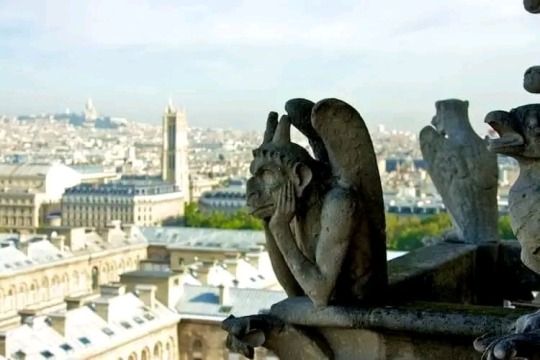


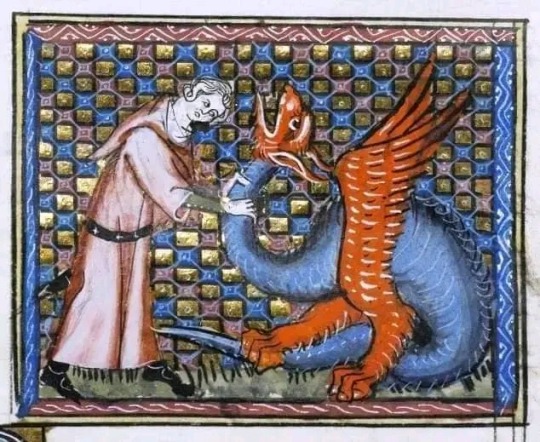




Gargoyles and Grotesques
A Gargoyle is an ingenious spout designed to convey water from a roof and away from the side of a building, preventing rainwater from running down masonry walls and eroding the mortar between.
Architects often used multiple gargoyles on a building to divide the flow of rainwater off the roof to minimize the potential damage from a rainstorm. A trough is cut in the back of the gargoyle and rainwater typically exits through the open mouth. They are usually an elongated fantastical animal because the length of the gargoyle determines how far water is directed from the wall. When Gothic flying buttresses were used, aqueducts were sometimes cut into the buttress to divert water away.
The term originates from the French gargouille, which in English is likely to mean "throat" or "gullet"; Latin gurgulio and similar words derived from the root gar, "to swallow", which represented the gurgling sound of water. We get our word gargle from this.
When not constructed as a waterspout and are only ornamental or artistic, the correct term for such a sculpture is a grotesque, chimera, or boss. Just as with bosses and chimeras, gargoyles are said to protect what they guard, such as a church, from any evil or harmful spirits.
In Rouen La Gargouille was said to have been the typical dragon with bat-like wings, a long neck, and the ability to breathe fire from its mouth. Either St. Romanus subdued the creature with a crucifix, or he captured the creature with the help of the only volunteer, a condemned man.
In each story, the monster is led back to Rouen and burned, but its head and neck would not burn due to being tempered by its own fire breath. The head was then mounted on the walls of the newly built church to scare off evil spirits, used for protection and to show the power of God. The ashes from the monster’s body were thrown into the river.
When it rained, water poured out the dragon’s mouth. An architect had the idea that this would be the perfect way to keep rainwater from running down the sides of the church and damaging the masonry. He carved similar dragon heads of stone and placed them all around the church. Is this true, who knows!
The term gargoyle is most often applied to medieval work, but throughout all ages, some means of water diversion, when not conveyed in gutters, was adopted. In ancient Egyptian architecture, gargoyles showed little variation, typically in the form of a lion's head. Similar lion-mouthed water spouts were also seen on Greek temples.
Both ornamented and unornamented waterspouts projecting from roofs at parapet level were a common device used for rainwater from buildings until the early 18th century.
From that time, more and more buildings used drainpipes to carry the water from the guttering roof to the ground and only very few buildings using gargoyles were constructed. This was because some people found them frightening, and sometimes heavy ones fell off, causing damage. In 1724, the London Building Act passed by the Parliament made the use of downpipes compulsory in all new construction.
0 notes
Text

The great sword of Dunvegan and it’s over 500 years old 🗡🏴.
This sword was a weapon of great power, it was made by the MacLeods of Suardal who were the Blacksmiths to the MacLeods of Dunvegan.
A Claymore (Claidheamh Mòr, or “great sword" in Gaelic) such as this would have cost a small fortune and was typically used by Clan Chiefs.
Its real power though, was in its length and weight. The blade is three feet (approx, 90cm) in length and together with its weight would have been lethal in a double-handed swing
The sword is difficult to date. Its features suggest the late 15th or early 16th century. A depiction of it on the tombstone of Alasdair Crotach MacLeod, the 8th Clan Chief, tells us it cannot be dated after 1528.
What makes this sword even more fascinating is that it is made with Scottish steel 🏴🏴, instead of German steel, which was more commonly used.
0 notes
Text
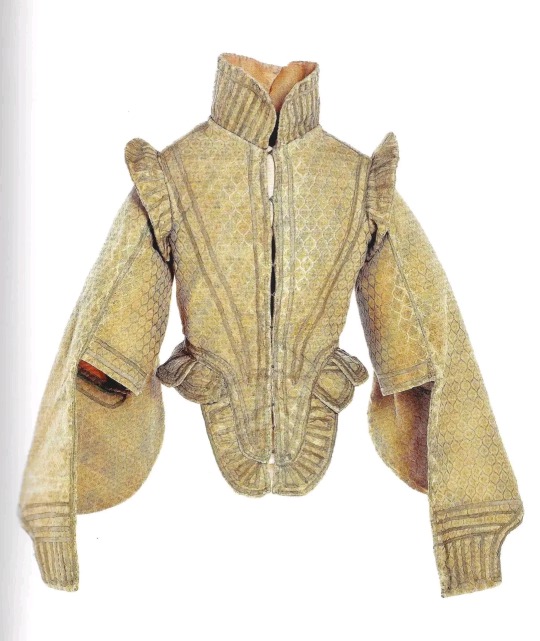


In the 1500s and into the 1600s, the wearing of a doublet was not confined to men’s clothing women also wore them, though very few examples survive for us to examine. The Musée des Arts Decoratifs, Paris holds this very fine Spanish style pourpoint or doublet from between 1590 and 1610.
It is made of a beautiful gold figured silk velvet with a small pattern repeat that has a strong graphic appeal. It is simply ornamented with green silk braid that accents all the style lines and structural elements. The deep front has a curved bottom and overlapping tabs that would mask the join of the skirts.
The high collar is stiffened, and lined with peach colored linen. The remainder of the pice is lined in silk taffeta.
The sleeves are the most interesting aspect, to me, anyway. The functional sleeves are elbow length and finish with false over sleeves that would reach the wrist if they could be worn in such a way.
The doublet closes down the center front with a series of concealed hooks and eyes.
0 notes
Text
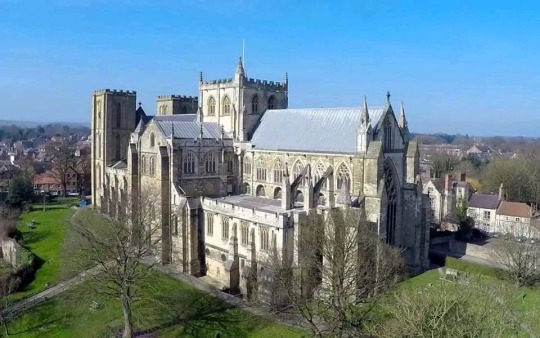
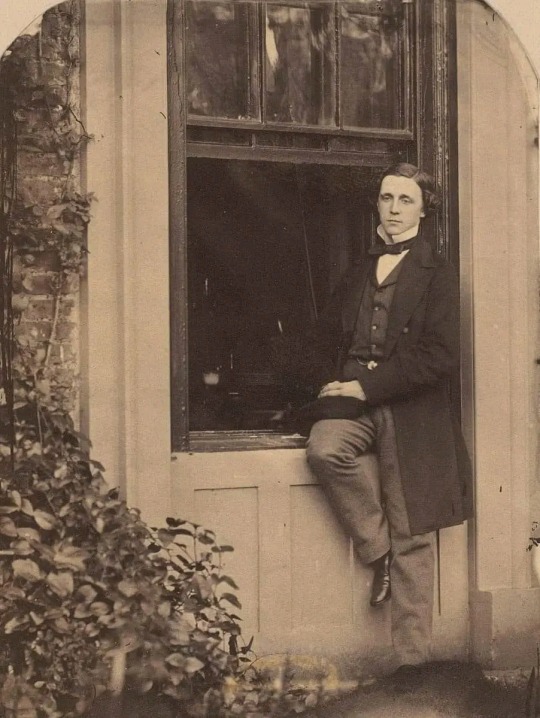







Lewis Carroll stories with a Yorkshire connection
Lewis Carroll, whose real name was Charles Lutwidge Dodgson, lived in Ripon as a young man. His father was canon of Ripon Cathedral from 1852 until 1858 and Carroll spent a lot of his time in the cathedral.
Here, he would have seen the misericords, which are carved with images that are particularly reminiscent of Wonderland. A carved griffin chasing a rabbit down a hole on one misericord may have inspired Alice’s fall down the rabbit hole.
A small misshapen character on another misericord looks rather like Alice after she followed the ‘drink me’ instruction and shrank. It has also been suggested that the rabbit hole may have been inspired by the cathedral’s crypt tunnel.
The Grade Two listed Old Hall, next to Ripon Cathedral, was home to the writer’s family.
Dodgson was born on 27 January 1832 at All Saints' Vicarage in Daresbury, Cheshire, the oldest boy and the third oldest of 11 children. When he was 11, his father was given the living of Croft-on-Tees, Yorkshire, and the whole family moved to the spacious rectory.
Carroll regularly visited cousins in Whitburn, in Tyne and Wear. On one beach walk he is said to have met a carpenter and supposedly came across a stuffed walrus in the town.
Carroll's poem Jabberwocky is said to have been completed in Whitburn, which is also home of Sir Hedworth Williamson, a relation of Alice Liddell.
Williamson introduced white rabbits into the grounds of his home, Whitburn Hall, where Carroll played croquet.
But perhaps the most intriguing connection is the carving of a cat in St Peter's Church in Croft, Darlington, where Carroll's father was rector.
It seems reasonable to assume his eye would have been caught by an unusual carving of a cat which, depending upon the angle it is viewed from, appears to be grinning.
The Norman church of St Mary’s.
Founded in 1120, the church the oldest building in Beverley is renowned for its beautiful pillars, many of them musically themed. But if you look hard enough, a very familiar character can be found at the entrance to St Michael’s Chapel where a perky upright rabbit – or hare? – stands on one side of a stone archway with his messenger bag, scroll and staff. Often missed by visitors, he dates to about 1330 and is long thought to be the inspiration for Lewis Carroll’s tardy White Rabbit in Alice in Wonderland.
He was on a family outing to Beverley when he spotted the rabbit’s figure in St Mary’s. His diaries refer to a journey between York to Hull during which he was almost certain to pass through Beverley and he had strong links with the area – his uncle was rector at Burton Agnes and Harpham from 1833 to 1840 and his grandfather lived at Hull.
We had a Walrus called Thor resting for several days in Scarborough around the New Year on his way North.
Ripon Cathedral in the small North Yorkshire city of Ripon is a seat of the Bishop of Leeds.
The first building was an Anglo-Saxon timber church founded by Celtic monks from Melrose Abbey in Scotland. This structure was replaced in stone by a church dedicated to St Peter by St. Wilfrid in 672, who brought stonemasons, plasterers and glaziers over from France and Italy to work on the building. Stephen of Ripon recorded
"In Ripon, Saint Wilfrid built and completed from the foundations to the roof a church of dressed stone, supported by various columns and side-aisles to a great height and many windows, arched vaults and a winding cloister."
This church was one of the earliest stone buildings to be built in the Anglo-Saxon Kingdom of Northumbria. The crypt of the present building, one of the oldest in the country, dates back to this period, a simple structure, it is said to be built in imitation of Christ's tomb. It remains almost as Wilfrid described it. The main chamber is entered by way of dark passages, one of the relics which Wilfrid had brought back from Rome was displayed in the eastern niche. Saint Wilfrid died in 709 and was buried in the church near the high altar.
In 875 the monastery was sacked by raiding Vikings. Sometime after 978 it was rebuilt once more, by Bishop Oswald, who intended it to serve secular priests.
The church was again devastated during the reign of the Saxon King Edred in 948 as a warning to Wulfstan, the Archbishop of York, who had formed an alliance with the Viking ruler of York, Eric Bloodaxe. King Edred marched north with an army and ravaged the province, burning Ripon.
A second minster was constructed at Ripon by Bishop Oswald, but met the fate of the first, this time in 1069 at the hands of William the Conqueror during his merciless 'Harrying of the North' in response to Saxon resistance to his rule. Thomas of Bayeux, the first Norman Archbishop of York, commenced the construction of a third church
The Early English west front was added in 1220, its twin towers originally crowned with wooden spires and lead. The west front is one of the best examples of Early English Gothic architecture in England.
The nave was mostly rebuilt in the Perpendicular or late Gothic style after the central tower collapsed in 1450. Major rebuilding was postponed due to the outbreak of the civil war now known Wars of the Roses but resumed after the accession of the first Tudor king Henry VII in 1485. The nave was widened and the central tower partially rebuilt.
In 1547, before this work was finished, King Edward VI dissolved Ripon's college of canons. All revenues were appropriated by the Crown and the tower never received its last Perpendicular arches. It was not until 1604 that the first Stuart king, James I issued his Charter of Restoration and it was once again became a collegiate church.
The charter was again revoked after the establishment of the Commonwealth under Oliver Cromwell. In 1660, King Charles II restored the charter after the restoration of the monarchy. The minster became the focal point of the newly created Anglican Diocese of Ripon in 1836, the first to be established since the Reformation, and was made a Cathedral.
0 notes
Text




BATTLE OF CULLODEN
16 April 1746
The battle of Culloden is claimed to be the last pitched battle to be fought on British soil. Although it was not the final action of the 1745 rising, it was decisive. Despite some holdouts and a number of small skirmishes, the Jacobite defeat finally ended the House of Stuarts aspirations to regain the throne of Great Britain.
Following the earlier attempts to take the throne in 1715 and 1719, the exiled House of Stuart attempted once more, and for the final time in 1745. Prince Charles Edward Stuart, the 'Young Pretender', raised his standard at Glenfinnan and despite an early success at the Battle of Prestonpans (21 September) the invasion of England came to naught.
Although having to retreat from Derby, the Jacobite’s scored a small success over the government troops at Clifton Moor (18 December) and then mauled another government army at Falkirk Muir (17 January 1746) although the battle itself was inconclusive.
Charles Stuart had been followed into Scotland by Prince William Augustus, Duke of Cumberland, and third son of King George II. Arriving at Aberdeen, Cumberland advanced against the Jacobite army reaching Nairn on 14 April. Lord George Murray decided on a night attack against the government army but many of the units lost themselves in the dark. The attack was eventually called off and the Jacobite’s retreated to back to Culloden Muir.
On the 16 April Cumberland advanced his army to Culloden and the Jacobite’s drew up on the moor opposite the government lines. Lord George Murray's Atholl brigade was on the far right of the line. The MacDonald’s, who traditionally had this honour, were on the extreme left and also furthest from the government lines. The government forces amounted to some 8000 men outnumbering the Jacobite army of 5000. Murray’s troops were also tired after their night march. Culloden was certainly not a battle of swords against muskets and both sides had artillery. But the tiredness of the Jacobites, the government superiority in artillery, numbers and their training were all factors in the result that followed.
The battle began with a brief artillery duel. The government gunners got the upper hand and sent a constant barrage of shot towards the stationary highland line. Eventually, Prince Charles ordered his men to advance. As they advanced the government artillery switched to canister and together with musket fire caused heavy casualties among the Jacobite’s.
Only part of the Jacobite right wing succeeded in reaching, and partially breaching the government front line. Although the front line broke, the regiments of Bligh (20th Foot) and Semphill (25th Foot) were pushed forward to close the breach. As more government soldiers moved up to counterattack as the Jacobite’s were pushed back. To the right of the Jacobite line were the walls of Culwhiniac Enclosure. Here the Campbell Militia had begun working their way around the flank of Murray's men. Demolishing part of the walls to allow the government cavalry through the Campbell’s poured volleys into their opponents. An attempt by Lord Gordon’s men to protect this flank proved ineffectual. Assailed from the front, and now also from their flank, the Jacobite right wing collapsed, tumbling back towards the second line.
On the left the MacDonald’s had not even closed with the government lines. Swept by Musketry and artillery fire and hampered by boggy ground, the regiments suffered a good number of men killed including, critically, some of their officers. As the left fell back Cumberland ordered some of his horse to ride the highlanders down but the boggy ground proved as much a hindrance to the cavalry as it did to the Jacobite’s.
Prince Charles attempted to stem the rout by bringing forward Brigadier Stapleton’s Irish Piquet’s and together with the Royal Ecossaise they managed to cover the Jacobite retreat although both suffered a number of casualties. Charles, ever the optimist, attempted to rally some units on the left but seeing utter defeat staring him in the face he allowed himself to be led off the field. With the collapse of the army, and its dispersal in different directions, the battle was over.
The Jacobite’s lost between 1500-2000 casualties compared with the government c.300. Although some Jacobite units later rendezvoused with Charles Stuart he ordered the army disbanded. Charles evaded capture for several months in the Outer Hebrides before departing to France. It was the House of Stuarts final attempt to take the throne.
Today the battlefield is wonderfully cared for by the National Trust for Scotland. There are excellent visitor facilities and a trail around the battlefield which is gradually being restored to its 1746 appearance.
For other Scottish Battles visit the Trusts Battlefield Hub at https://www.battlefieldstrust.com/resource-centre/
Pictures:
1. The Battlefield
2. The Well of the Dead
3. The Memorial Cairn
4. Leanach Farmhouse on the site of a cottage where the wounded were treated
All images: The Battlefields Trust
0 notes
Text

CLEGHORN, MILDRED IMOCH (1910–1997).
Traditional doll maker, schoolteacher, and Fort Sill Apache tribal leader, Mildred Imoch (En-Ohn or Lay-a-Bet) was born a prisoner of war at Fort Sill, Oklahoma, on December 11, 1910. Her grandfather had followed Geronimo into battle, and her grandparents and parents were imprisoned with the Chiricahua Apache in Florida, Alabama, and at Fort Sill. Her family was one of only seventy-five that chose to remain at Fort Sill instead of relocating to the Mescalero Reservation in New Mexico in 1913.
Mildred Cleghorn attended school in Apache, Oklahoma, at Haskell Institute in Kansas, and at Oklahoma State University, receiving a degree in home economics in 1941. After she finished her formal education, she spent several years as a home extension agent in Kansas, Oklahoma, and New Mexico, and then worked for sixteen years as a home economics teacher, first at Fort Sill Indian School at Lawton and then at Riverside Indian School at Anadarko. Later, she taught kindergarten at Apache Public School in Apache. She was married to William G. Cleghorn, whom she had met in Kansas, and their union produced a daughter, Peggy. In 1976 Mildred Cleghorn became chairperson of the Fort Sill Apache Tribe, newly organized as a self-governing entity. Her leadership in that government revolved around preserving traditional history and culture. She retired from the post at age eighty-five in 1995.
Cleghorn's many awards and recognitions included a human relations fellowship at Fisk University in 1955, the Ellis Island Award in 1987, and the Indian of the Year Award in 1989. She also served as an officer in the North American Indian Women's Association, as secretary of the Southwest Oklahoma Intertribal Association, and as treasurer of the American Indian Council of the Reformed Church of America.
Above all, Mildred Cleghorn was a cultural leader. She spent a lifetime creating dolls authentically clothed to represent forty of the tribes she had encountered in her teaching career. Her work was exhibited at the Smithsonian Institution in Washington, D.C. Her life ended in an automobile accident near Apache on April 15, 1997
0 notes
Text

They flash upon that inward eye
Which is the bliss of solitude;
And then my heart with pleasure fills,
And dances with the daffodils.
~William Wordsworth, Daffodils
0 notes
Text

April 16, is the feast day of Saint Benedict Joseph Labre (1748-1783) on the liturgical calendar of the Roman Catholic Church.
☞Saint Benedict Joseph Labre was an 18th-Century French mendicant (beggar), Franciscan tertiary, & Catholic saint who spent much of his life travelling on foot to visit the various Holy sites throughout Europe, & who met his earthly demise at the age of 35 on today’s date 241 years ago, Wednesday, April 16, 1783 when he died from the effects of malnutrition near the church of Santa Maria ai Monti, only a few blocks from where he had been living in the ruins of the Roman Colosseum in Rome, Italy.
☞Saint Benedict Joseph Labre is the patron saint of unmarried men (bachelors), rejects, those suffering from mental illness or insanity, beggars, hobos, & homeless people.
☞The photograph depicts an undated painting of Saint Benedict Joseph Labre by an unknown artist.
0 notes
Text
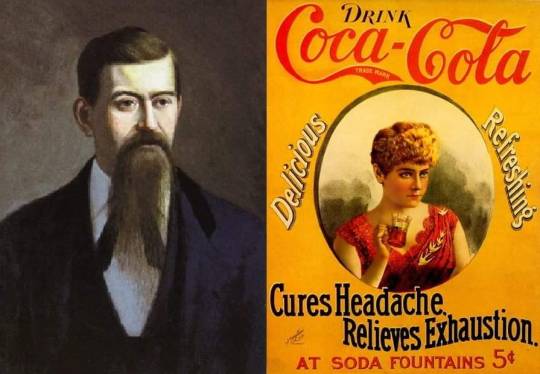
☞Today in History -- On today’s date 159 years ago, Easter Sunday, April 16, 1865 during the War Between the States, the Battle of Columbus, also known as the Battle of Girard, was fought at Girard, Alabama & Columbus, Georgia, resulting in a Union victory.
☞There is a widespread, although erroneous, belief that the Battle of Columbus, which was fought one week after Confederate general Robert E. Lee surrendered the Army of Northern Virginia, was “the last battle” of the War; however, the last significant land battle of the War Between the States was the two-day Battle of Palmito Ranch, which was fought over one month later on May 12 & 13, 1865 near Brownsville, Texas, resulting in a Confederate victory.
☞It is curiously interesting that noted pharmacist & Confederate Colonel John Stith Pemberton (1831-1888), the inventor of Coca-Cola, was severely wounded during the Battle of Columbus, which caused him to endure chronic pain thereafter & resulted in his obsession with inventing various pain-killing medicinal formulæ -- ultimately resulting his concocting the recipe for his celebrated soft drink, which originally contained both cocaine from “coca” leaves & caffeine from “kola” nuts, whereby the drink received the name of “Coca-Cola.”
☞Colonel Pemberton made many health claims for Coca-Cola, marketing it as “delicious,” “refreshing,” “pure joy,” “exhilarating,” & “invigorating,” & touting it as “an invaluable brain tonic” that would cure headaches, relieve exhaustion, & calm nerves.
☞Note: Coca-Cola, now the world’s most popular soft drink, was invented in Atlanta, Georgia by Colonel Pemberton in 1886, about one year after pharmacist Charles C. Alderton (1857-1941) of Waco, Texas invented Dr. Pepper, which is now the most popular soft drink in Texas. Alderton’s soft drink was named in honor of Charles Taylor “Old Doc” Pepper, M.D. (1830-1903) of Virginia, who had served as a surgeon in the Confederate Army during the War Between the States.
☞Note: Colonel John Stith Pemberton, C.S.A. (1831-1888) of Georgia, the inventor of Coca-Cola, is not to be confused with General John Clifford Pemberton, C.S.A. (1814-1881) of Pennsylvania, who resigned his commission in the U.S. Army at the beginning of the War Between the States, & who is noted for his defense of Vicksburg during the “Siege of Vicksburg” in the Summer of 1863.
☞The left-hand photograph depicts an undated portrait of Colonel John S. Pemberton, C.S.A. The right-hand photograph depicts a circa-1890s advertisement for the Confederate colonel’s famous soft drink -- Coca-Cola.
0 notes





